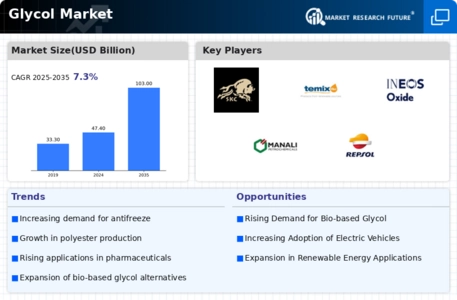Market Share
Glycol Market Share Analysis
The Glycol market has a very significant connection to pricing strategies as these are essential in determining market share. Some firms go for cost leadership by offering competitive prices targeting customers who are price sensitive. In some instances, glycol products could be positioned as premium ones with a view of commanding high prices in the market. Striking a balance between price and perceived value is necessary to efficiently address various customer segments and remain competitive.
Distribution channels also play an important role in determining market share positioning for glycols producers. This helps in building strong distribution networks that can reach many customers while ensuring product availabilities are efficient. Depending on the prevailing dynamics within the specific markets and the target clients, companies may decide to involve distributors, retailers or even embark on direct contact with consumers themselves.
Also noteworthy is that strategic partnerships and collaborations are increasingly pervasive across the Glycol industry. For instance, alliances formed with other companies along the supply chain or partners from related industries provide access to new markets, technologies or resources. These happen when two entities merge their operations together so as to increase their shares of various markets they operate into.
Another important strategy used by glycol manufacturers is geographic expansion. Choosing emerging markets or regions where there is high demand for such solutions has an advantage in that it enables them tap into new pool of potential buyers besides diversifying their income sources. By understanding regional preferences and regulatory landscapes, companies can tailor their strategies to meet the unique needs of different markets.
Furthermore, brand development plus marketing efforts form crucial components of market share positioning strategies within Glycol sector. A strong positive brand image sets apart products for one firm from others as well as creating consumer confidence. Marketing campaigns that effectively project benefits as well features including sustainability dimension can impact on how customers perceive about glycols hence influencing its position in terms of market shares.
Finally maintaining a grip over innovations and R & D is crucially important if one has to keep a competitive edge within the Glycol industry. As such, by developing new formulations, production processes or applications for glycol products, companies can stay ahead in the race and cater to emerging market demands. Companies which do not stand still in terms of technological advancement will always offer cutting edge solutions that attract customers thus cementing their position on the market.
In conclusion there is still much room for growth in regards to global glycols demand. The sector has several different industries operating under it however; this is only possible because of its dynamism and evolution. Whereas some parts are specifically used in automotive industry such as ethylene glycol that is known for its strong freeze protection properties when used as an engine coolant. This attractiveness of this business need to be further enhanced because as long as the construction industry continues using these chemicals on HVAC systems glycols would be required.








Leave a Comment